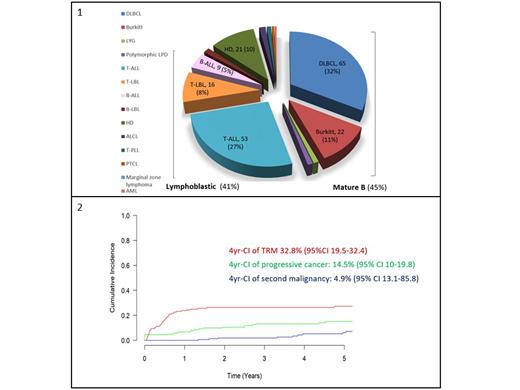Introduction Ataxia telangiectasia (A-T) is a multisystem disorder caused by biallelic germline pathogenic variants (PV) in the ATM gene. An important feature of A-T is an increased predisposition to cancer with a reported incidence of 25%, primarily attributed to hematological malignancies. Patients with A-T and cancer are usually excluded from therapeutic clinical trials, limited information thus exists concerning their treatment outcomes and toxicity profiles and consequently, optimal management strategies are unclear and an unmet need. In this multinational study, we aimed to investigate the characteristics and outcomes of leukemia and lymphoma in a large cohort of children with A-T and to determine risk factors which impact treatment outcome in order to generate consensus and data-based prospective treatment recommendations.
Methods This study of patients aged ≤25 years with A-T and hematological malignancies was conducted through the International BFM Study Group. Patient data were collected from medical records, including specific patient comorbidities. Each reported ATM PV identified in the cohort was classified as null (resulting in complete loss of ATM activity) or hypomorphic (allowing residual ATM activity) according to the expected functional activity of the ATM protein and published functional studies. Patients with reported ATM PV were then classified as Group A (two null PV) or Group B (at least one hypomorphic PV).
Results We report 202 pediatric and adolescent/young adult patients with A-T and hematological malignancies from 25 countries. The cohort included 82 patients with ALL/LBL (41%), predominantly (85%) of T-cell lineage, 91 with mature B-cell lymphomas (45%), 21 with Hodgkin lymphoma (10%) and 8 with other hematological malignancies (4%) (Fig 1). Of 111 patients with classifiable germline ATM variants, 82 (74%) were classified as Group A and 29 as Group B (26%). The distribution of patients with Group A and Group B germline ATM PV differed considerably between tumor types with 44% of the patients with lymphoblastic leukemia/lymphoma classified as Group B vs. 5% of those with mature B cell lymphomas ( p<.001). In total, 185 patients (92%) treated with curative intent were included in the outcome analyses, 135 (73%) of whom were treated with attenuated therapy regimens. Four-year OS and EFS for the entire cohort were 50.8% (95% CI 43.6-59.1) and 47.9% (95% CI 40.8-56.2), respectively. Surprisingly, cure rates of patients with A-T and malignancy did not appear to improve significantly with therapy modernization over the last four decades with 4-year EFS rates of 41.6% (95% CI 26.6-65), 49.6% (95% CI 38.8-63.4) and 48.0% (95% CI 37.4-61.7) for those treated before 2000, between 2000-2009 and since 2010, respectively ( p=.54). The major cause of treatment failure for the entire cohort was treatment-related mortality (TRM) with a 4-year cumulative incidence of 32.8% (95% CI 19.5-32.4), followed by progressive cancer in 14.5% (95% CI 10-19.8) and second malignancy in 4.9% (95% CI 13.1-85.8) (Fig 2). We identified factors that were significantly associated with survival for this unique patient population. Older age had a significantly deleterious effect upon survival with 4-year EFS rates of 69.1% (95%CI 55.9-85.4), 45.3% (95% CI 34.5-59.4), 39.8% (95% CI 25-63.2), and 33.7% (95% CI 20.8-54.6) for children aged ≤5 years, 5-10 years, 10-15 years and ≥15 years, respectively ( p=.003). The type of germline ATM PV also had a significant impact: 4-year EFS for patients with Group B ATM PV was 78.7% (95% CI 63.7-97.2) vs. 39.4% (95% CI 29-53.3) for Group A ( p<.001). Group A PV were associated with an increased TRM (OR 9.3; 95% CI 1.6-180.1; p=.042) and decreased EFS (HR .371 95% CI 16.6-82.6; p=.009).
Conclusions We demonstrate in this first comprehensive international study that leukemia and lymphoma in children with A-T are curable. While the standard treatment stratification system for patients with hematological malignancies without A-T focuses upon cancer relapse/progression as the main cause of treatment failure, TRM was the main cause of therapy failure in patients with A-T and was strongly associated with the underlying germline ATM variant type. This study further fulfills an unmet need for international collaboration and provides a platform for data-based guidelines for a novel risk stratification system and optimal therapy selection for this unique patient population.
Disclosures
Elitzur:Medison Pharma: Honoraria; Jazz Pharmaceuticals: Honoraria. Baruchel:AstraZeneca: Other: honoraria for advisory board participation but given to my institution; Servier: Honoraria, Research Funding; Clinigen: Honoraria; Serb: Other: honoraria for advisory board participation; Jazz: Other: honoraria for advisory board participation. Schmiegelow:Medscape: Other: Speaker's fee; Amgen: Other: Speaker's fee; Servier: Honoraria, Other: Educational grants; Jazz Pharmaceuticals: Honoraria; Illumina: Honoraria. Abla:Springworks Therapeutics: Consultancy, Honoraria. Jacoby:Novartis: Honoraria, Speakers Bureau; Medison: Speakers Bureau. Lo Nigro:Clinigen: Consultancy, Membership on an entity's Board of Directors or advisory committees; Jazz Pharmaceutical: Consultancy, Membership on an entity's Board of Directors or advisory committees; Novartis: Consultancy, Membership on an entity's Board of Directors or advisory committees; Amgen: Consultancy, Membership on an entity's Board of Directors or advisory committees. Tasian:Syndax Pharmaceuticals: Membership on an entity's Board of Directors or advisory committees; Beam Therapeutics: Research Funding; Incyte Corporation: Research Funding; Kura Oncology: Membership on an entity's Board of Directors or advisory committees, Research Funding; Aleta Biotherapeutics: Membership on an entity's Board of Directors or advisory committees; Amgen: Other: travel support . Tran:Servier: Consultancy, Honoraria; Jazz Pharmaceuticals: Consultancy, Honoraria. Minard-Colin:Adaptimmune Therapeutics plc: Consultancy; BMS: Consultancy; Roche: Consultancy; Aztra: Consultancy. Attarbaschi:JazzPharma: Honoraria.


This feature is available to Subscribers Only
Sign In or Create an Account Close Modal